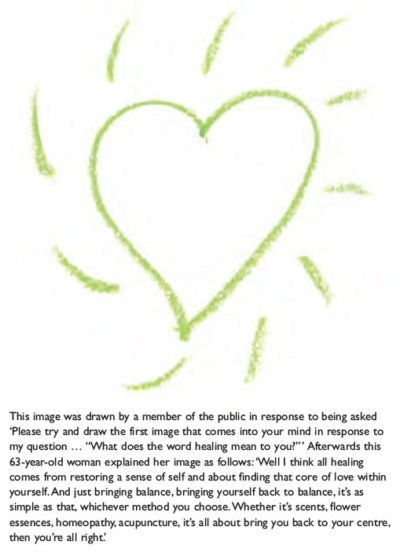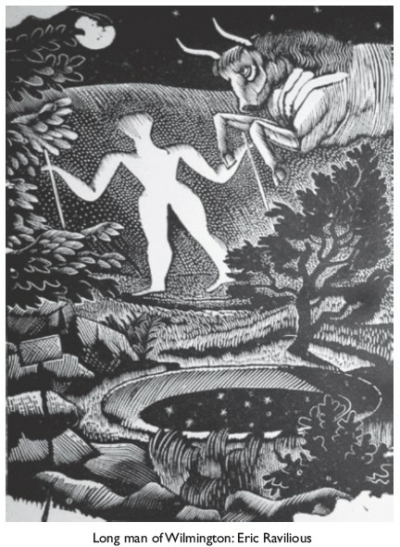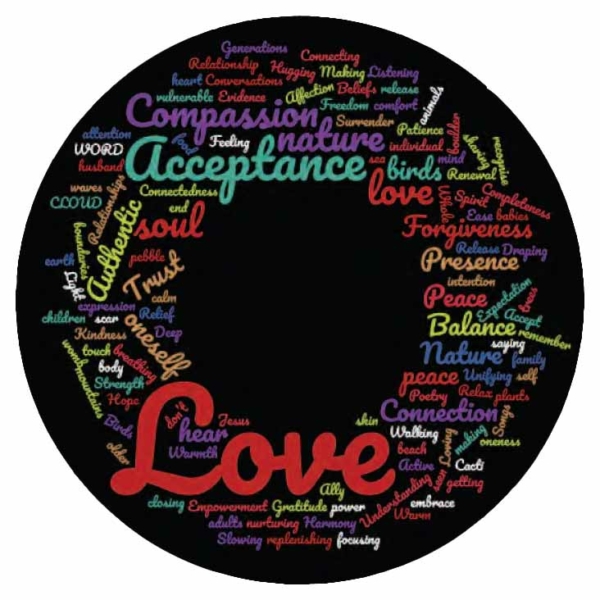Healing and love
Paul Dieppe, Emeritus professor of health and wellbeing, University of Exeter
Sarah Goldingay, Senior lecturer in the Department of Drama and director of the Centre for Performance, Sciences and Community, University of Exeter
Natalie Harriman, Research manager, Brighton and Sussex Medical School
Ayesha Nathoo, Affiliated research scholar, Department of History and Philosophy of Science, University of Cambridge; honorary university fellow, University of Exeter
Sara Warber, Clinical professor emerita, family medicine, University of Michigan
Published in JHH 18.3-Shifting the paradigm
Healing
The word healing is omnipresent. There seems to be general agreement that our post-pandemic, warming world, and the people in it, are in urgent need of healing.
But what is healing? The word healing is used in many different ways; it can mean an intervention, a state, a process or an outcome, and it can be used about any number of issues, including nature and the planet, as well as animals and people. Our main interest is in the healing of us human animals. But, in spite of years of study, including many interviews and discussions with healers, ‘healees’ (those of us who have experienced healing), healthcare professionals and members of the ‘general public’, we have become convinced that it is a very varied, individual, experiential issue, that defies definition.
But if healing is primarily experiential, and cannot easily be described or defined, we are faced with the dilemma that we are trying to investigate we know not what. How can you explore a subject when you do not know what you are exploring (scientific enquiry demands that we define the territory and questions before doing our research, unlike humanities scholarship, as discussed later)? Our answer over the past few years has been to say that we are using a phenomenological approach: simply trying to document the experiences and phenomena that surround the diverse events that get labelled as human healing, and share what we find.
Another approach would be to try to examine how other scholars have defined the word. So here are some of their definitions:
- a transformational change (Csordas, 1990)
- transcending suffering (Egnew, 2005)
- from feeling ill to wellness (Kirmayer, 2013)
- regaining a sense of balance and peace (Hsu, 2008)
- making whole again (Cassel, 2004)
- reducing suffering and finding meaning (Scott, 2008)
Firth and colleagues (2015) offer a rather more cumbersome but inclusive definition:
‘Healing is a holistic, transformative process of repair and recovery in mind, body and spirit resulting in positive change, finding meaning, and movement towards self-realisation of wholeness, regardless of the presence or absence of disease.’
But we are concerned that the diversity of these definitions, and their rather opaque nature, leave us relatively little further on.
A different approach to our problem might be to try to break down some of the different aspects of human healing, and examine each element separately; arguably, a somewhat reductionist approach, but perhaps one worth considering.
So first let us ask, what are we trying to heal humans of? We might call this trying to find the ‘substrates’ of human healing. To the Western biomedical mind the answer would be disease (and possibly illness); but such an approach differs from many other ways of thinking about the world, and is deeply embedded in the current narrow, materialistic, scientific, positivist view of the world. We believe that older wisdom and ways of thinking about health, which almost always included a spiritual element, such as ancient Indian, Chinese, Greek and Arabian approaches, offer a more helpful perspective on what healing is for and about. Absence of harmony is often talked about by ancient healers and sages, who suggest that mind, body and soul need to be in balance and accord with one another. Absence of health for them is about absence of balance, harmony and connectivity both within you, and with other aspects of the universe. We recently heard such a concept voiced by a contemporary war veteran, who said that while suffering from PTSD he had been suffering from ‘soul separation’ – a fragmentation of the continuity between his soul and body/mind. As he recovered, he told us, he became connected and whole again. All of us want to be able to feel joy and wonder; this requires us to be connected within, and in balance.
‘Maybe love, not consciousness or energy, is the fundamental property of the universe’
Continuing with the reductionist approach, our next question might be how does healing return us to that state of balance and harmony? The commonest concept among both contemporary healers and ancient traditions is that of energy flow or exchange; the idea that some form of basic energy needs to be (re)balanced within us (Chinese Chi, Indian Prana etc) and blockages removed to regain energy flow. Conventional Newtonian science struggles with this idea as it cannot measure any such energy, and therefore rejects the concept out of hand. But both the older wisdom traditions, and some current philosophical and scientific ways of looking at the world, see such ‘energy’ as the fundamental stuff of the universe. For example, quantum mechanics has led to such concepts. Max Planck, one of its founders, said in 1931:
‘I regard consciousness as fundamental. I regard matter as derivative from consciousness. We cannot get behind consciousness. Everything that we talk about, everything that we regard as existing, postulates consciousness.’
Others prefer words such as information, love, or god, to that of energy or consciousness, but the same fundamental idea is now widely shared, particularly within the growing philosophy of panpsychism (the doctrine or belief that everything material, however small, has an element of individual consciousness).
So, if we need to be in balance/harmony, and we get there by rebalancing of energy, our next question needs to be: how can this healing be facilitated? How can disruptions of the universal energy/consciousness that we are all a part of be put right? We think the key to this is ‘connectivity’ – making meaningful connections with other living things (people, animals, trees, nature) that nourish us and allow the essence of life to flow and to restore our harmony of soul/mind/body. And the process is reciprocal. Healing is achieved through nourishing connections and exchanges.
Our research accords with these notions of the nature of healing.
For example, from our work in the Catholic healing sanctuary at Lourdes, we came to the conclusion that ‘nourishing exchanges’ between people were critical (Goldingay et al, 2021) and when we studied the experiences of healing moments by collecting data from healers and their ‘healees’, what emerged was that healing moments, or transformational events, were facilitated by connectivity, quiescence and energy channelling (Rhatz et al, 2017).
And if we ask people in current healthcare settings to provide us with one word that is most pertinent for them in relation to healing, the standout word is love (Dieppe et al, 2020). Similarly, healers often use the word love when describing healing (Warber et al, 2004). So perhaps we need to think about love rather than universal consciousness, energy, or information?
‘BHMA’s ‘wisdom project’ should … learn from the wisdom of ancient healers and healing practices, facilitated by love’
Love
Love, like healing, is experiential and impossible to define. Poets and artists have struggled to describe the feelings that accompany love for centuries. You can only experience love, and when different people try to describe what those experiences are like, you hear many different, often clumsy, attempts to explain it using a variety of metaphors. Like healing, love can hit you hard and fast (love at first sight), or it can creep up on you slowly. Your love of your children may be a very different experience from that of your love of your dog, your football team, or the love you experience when hearing your favourite piece of music – but you love them all in different ways. Love for another person has been defined as being in a state of mind where the welfare of the other person is much more important to you than your own; definitions of that sort are available, for example, the Greeks delineated nine different types of love. But these definitions and descriptions do not come near conveying the essential experiential nature and feelings of love.
We have undertaken three research projects in which we tried to ascertain what people thought healing was about, and love featured strongly in all of them. Our first approach was to ask members of the public to draw a picture of what the word healing meant to them, and we asked them to talk about their image (Rhatz et al, 2019). Hearts were commonly drawn, and people talked of the importance of love (see example on page 15).
In another study we asked people to provide us with one word that was most important to them in relation to healing. We did this in a variety of contexts, with healthcare audiences as well as the general public, and using different ways of allowing them to find their word, such as asking them to write it on a card and pin the card to a string or board – we wanted to give them both space and anonymity (Dieppe et al, 2020).
Finally, when interviewing healers in the UK, we heard that many of them thought that ‘unconditional love for the other person’ was the most important element of their interactions with their clients.
Maybe love, not consciousness or energy, is the fundamental property of the universe? Evidence in support of such an idea comes from near death experiences (NDEs). Many of those who have had major NDEs describe being in a place in which they were enfolded in perfect,unconditional love.
Perhaps what we need today is recognition of the importance of love in our dealing with others, including within healthcare consultations. And perhaps western medicine needs to stop rejecting anything it does not understand, and be more open to healing and love. Some organisations have already moved in that direction. For example the American Holistic Medicine Association has asserted that ‘unconditional love is life’s greatest healer’; but most conventional medical societies avoid the word.
Finally, if we are going to take our understanding of experiential issues such as healing and love forward in healthcare contexts, we need to move away from an exclusively empirical, scientific approach to their investigation, and work with scholars of the arts and humanities to create new transdisciplinary paradigms. We need to work with scholars who can embrace pluralism, deal with ambiguity and contradictions, and explore meaning making as a central part of their mission, with freedom from the constraints of economic value and measurable outcomes. In addition, we must acknowledge and incorporate the experiential knowledge of healers into our understanding of the subject.
The ‘wisdom project’ should acknowledge and learn from the wisdom of ancient healers and healing practices, facilitated by love. Ours is a caring profession, and love in action is about caring.
Acknowledgments
We would like to acknowledge the financial support of the NOVA institute (previously the Institute for Integrative Health) in Baltimore, and the BIAL research foundation.
References
Cassell EJ (2004) The nature of suffering and the goals of medicine (2nd ed). Oxford University Press.
Csordas TJ, Kleinman A (1990) The therapeutic process. In: TM Johnson, & CF Sargent (eds) Medical anthropology: Contemporary theory and method. Praeger Publishers.
Dieppe P, Goldingay S, Warber SL (2020) Healing and wellness. In: W IsHak (ed) The handbook of wellness medicine. Cambridge University Press.
Egnew TR (2005) The meaning of healing: transcending suffering. Ann Fam Med, 3, 255–62.
Firth K, Smith K, Bellanti DM, Crawford C & Avant K (2015) Healing: a concept analysis. Global Adv Health Med, 4, 44–50.
Goldingay S, Rhatz E, Warber S & Dieppe P (2021) Nourishing exchanges: care love and chronicity in Lourdes. In: C Hatala (ed) Routledge Special collection on Religion, Spirituality and Health.
Hsu C, Phillips WR, Sherman KJ, Hawkes R & Cherkin DC (2008) Healing in primary care: a vision shared by patients, physicians, nurses, and clinical staff. Ann Fam Med, 6, 307–14.
Kirmayer LJ (2013) The cultural diversity of healing: meaning, metaphor, and mechanism. Heart Views, 14, 39–40.
Planck M (1931) Interview in The Observer, 25 January.
Rahtz E, Bonnell S, Goldingay S, Warber S & Dieppe P (2017) Transformational changes in health status: a qualitative exploration of healing moments. Explore, 13(5) 298–305.
Rahtz E, Warber SL & Dieppe P (2019) Understanding public perceptions of healing: an arts-based qualitative study. Complement Ther Med, 45, 25–32.
Scott JG, Cohen D, Dicicco-Bloom B, Miller WL, Stange KC & Crabtree BF (2008) Understanding healing relationships in primary care. Ann Fam Med, 6, 315–22.
Warber SL, Cornelio D, Straughn J & Kile G (2004) Biofield energy healing from the inside. J Altern Complement Med, 10(6) 1107–13.








